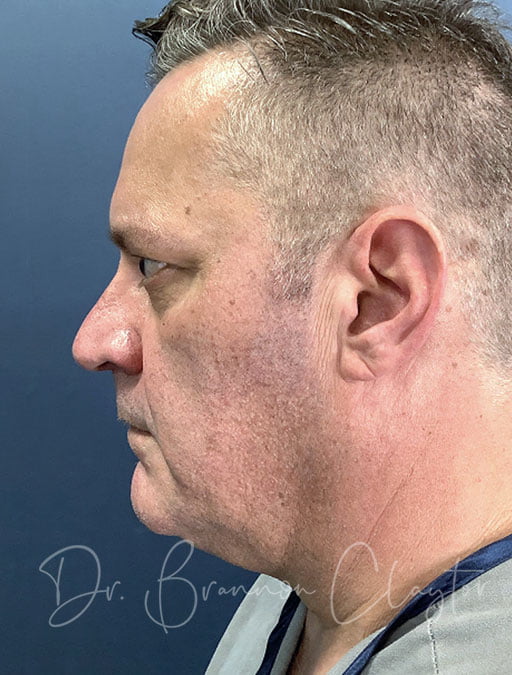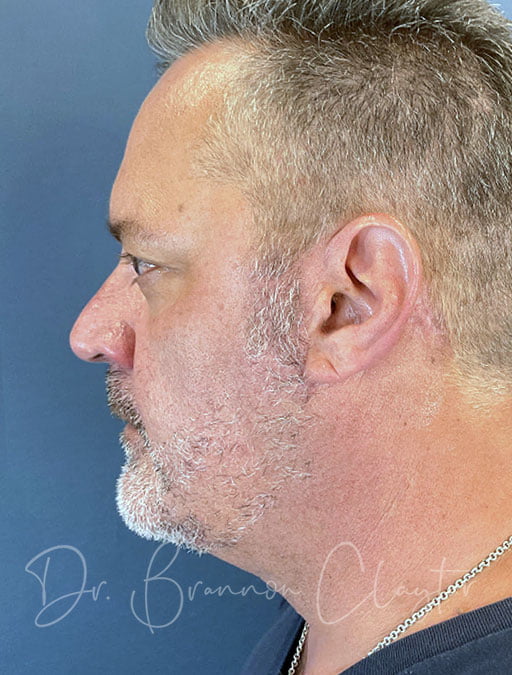Facelift for Men (Rhytidectomy)
How is facelift surgery different for men?
While aging is a natural process that all men should celebrate, it doesn’t have to mean settling for a loose, sagging appearance. Unlike facelift surgery for women which focuses on slimming and narrowing the lower face, a male facelift, or male rhytidectomy, restores a chiseled jawline and emphasizes a strong chin. While performing men’s facelift surgery, Philadelphia facelift surgeon Dr. Brannon Claytor considers the following factors unique to a man’s facial anatomy:
- Men’s skin is thicker than women’s, making it more challenging to manipulate
- Men’s facial muscles tend to be thicker than women’s
- A receding hairline can make it challenging to hide surgery scars
- Men tend to have more “jowling” in the lower face caused by fat deposits beneath the chin
Dr. R. Brannon Claytor
Dr. Claytor is board certified by the American Board of Plastic Surgery and holds over 15 years of experience as a cosmetic plastic surgeon. An innovator and teacher in the field of plastic surgery, he uses advanced techniques like the drain-free tummy tuck and deep plane facelift to streamline recovery and provide natural-looking, durable results.
Men’s Facelift Technique: How the Aesthetic Goals, Incisions, and Results Differ From Women’s Facelifts
In this video, Dr. Claytor explains how male facelifts differ from women’s facelifts in both technique as well as aesthetic goals, and also illustrates how he carefully performs male facelifts to ensure his patients maintain a masculine, natural-looking appearance.
What are the benefits of a male facelift?
A facelift procedure reverses the signs of aging in the mid to lower face, including the cheeks, mouth, chin, and neck, by:
- Reducing fine lines and wrinkles (especially those running from the nose to mouth)
- Restoring facial volume loss
- Removing facial fat as needed (typically in the jowls and neck)
- Correcting facial scarring
- Tightening loose skin and muscle
What are my men’s facelift options?
As a double-board certified plastic surgeon and facelift specialist, Dr. Claytor employs the most up-to-date techniques to enable his male patients to achieve the safest, most natural-looking results from their facelift. He performs a range of facelift procedures based on each patient’s unique facial structure and aging frustrations, including the short scar (Mini Facelift), SMAS plication facelift, and deep plane facelift. Dr. Claytor’s expertise also enables him to combine a facelift with an eyelift (blepharoplasty), brow lift, laser skin resurfacing, and/or facial fat grafting to achieve optimal results.
Schedule your consultation with Dr. Claytor to evaluate your goals and create a procedure plan.
“The whole experience was fantastic! The results exceeded my expectations! I look and feel 10 years younger. Dr. Claytor and his staff made me feel so at ease and comforting. He is an excellent surgeon with a wonderful bedside manner and personality. It is one of the best decisions I ever made. I would highly recommend Dr. Claytor; in fact my neighbor has an appointment with him next month.”
Mini facelift
Men who are looking to correct drooping cheeks, jowls, and loose skin or banding on their necks without surgery or downtime are good candidates for a mini facelift. In our thirties and forties, Botox, fillers, lasers can help maintain a youthful lift, but those who reach the point of “filler fatigue” are likely ready for a mini facelift. Dr. Claytor performs the mini facelift under local anesthesia in our Quad A-accredited Surgical Facility right in our office. Patients recover quickly and have little downtime or discomfort following surgery.
A mini facelift can correct the following concerns:
- Jowling
- Marionette lines
- Sagging cheeks
- Neck banding or loose skin on the neck
Short scar facelift
The short scar facelift is a procedure that Dr. Claytor performs on male patients who are primarily looking to rejuvenate droopy jowls and sagging skin in the lower face & neck. The short scar facelift also addresses the marionette lines and loose skin & banding on the neck that develops with age. Performed under local anesthesia in our Quad A-accredited Surgical Facility in Bryn Mawr, the incision for the short scar facelift extends from the sideburn hairline down to the base of the earlobe. This minimal incision is hidden behind the tragus in the ear, leaving a small scar behind the ear. This technique is excellent for professionals and younger patients who have mild sagging in the lower mid-face and jawline. Short scar facelift patients experience a recovery period of fewer than two weeks.
Full facelift
A full facelift involves incisions that extend further along the sideburn hairline and then continue around to the back of the ear. Some of these incisions may even extend into the hairline back behind the ear. The rationale behind the more extensive dissection is to achieve more lifting and skin removal at the neck region. Men who have excess skin and fat in their neck will require a full facelift with scars extending back behind the ear to achieve a more defined jawline and neck transformation. Male patients may also require liposuction to remove fat from beneath the chin and on the neck.
Beneath the skin at the level of the SMAS (Superficial Muscular Aponeurotic System), the facial structure changes with age, gravity, sun, and diet. The function of the SMAS is to support the skin; but, as the skin loses its elasticity and collagen support, gravity will slowly cause it to sag, resulting in loose jowls and drooping cheeks.
“I was given Dr Claytor’s name by my dermatologist, who didn’t know him but had seen his work on the faces of some of her patients and was impressed by the natural looking results. She was right, no one who didn’t know I had the procedure could tell, and I was out in public just one week afterwards. Everyone says, you look really good, did you lose weight, or change your hair? From start to finish the process was easy, everyone at the practice was helpful, my concerns were addressed and I all my questions answered.”
SMAS plication facelift:
SMAS (Superficial Muscular Aponeurotic System) is the scaffolding on which the skin resides. It is a layer of fibrous tissue and muscle that exists from just in front of the ear and extends to the neck. During the SMAS plication facelift procedure, Dr. Claytor folds the SMAS upward and laterally. This is performed with a running layer of sutures which lifts a layer of SMAS at the level of the cheekbones. This plication elevates the underlying facial structures and tightens the skin. Once the SMAS is plicated, the excess skin is trimmed. During a SMAS plication facelift, there is little disruption of the underlying ligaments which act as sturdy pillars from the bone to the SMAS. This procedure gives male patients a defined jawline, tighter neck, and an overall rejuvenated appearance.
Deep plane facelift:
Dr. Claytor is one of the few Philadelphia facelift surgeons with the expertise and skill to perform the deep plane facelift. Performed under local anesthesia in our office Quad A-accredited Surgical Facility, the deep plane facelift allows the skin, SMAS, and muscle to remain attached as a composite unit allowing for a more natural youthful positioning. Dr. Claytor will make a small incision in the sideburn hairline through which he releases the ligaments that tether the SMAS to the underlying fascia. He will then manipulate the SMAS and muscle together, pulling the SMAS tight and anchoring it to the temporal fascia. He then trims the excess skin to achieve a natural repositioning and a more youthful, volumizing result. Because a deep plane facelift does not put tension on the skin, Dr. Claytor is able to achieve a natural, long-lasting result. This facelift technique is particularly suitable for older patients who desire to remove jowls, loose neck skin, and drooping cheeks. Because the surgery can be done safely and comfortably under local anesthesia, patients experience a faster recovery and less bruising. Dr. Claytor will often combine a deep plane facelift with a blepharoplasty and/or a men’s neck lift to achieve full-facial rejuvenation.
- Key Benefits
- Glossary
- Addresses deep wrinkles for a refreshed, younger-looking appearance
- Defines the jawline and chin for a masculine profile
- Shaves about ten years off of your appearance
- Customized to include eye lifting and brow lifting as needed
Rhytidectomy: The medical term for a facelift. It refers to a procedure that improves visible signs of aging in the face and neck.
SMAS (Superficial Musculoaponeurotic System): A layer of tissues and muscles in the face that is often tightened or manipulated during facelift surgery to create a more youthful appearance.
Mini-Facelift: A less invasive procedure that focuses on the lower part of the face, with shorter recovery time.
Mid-Facelift: A surgical procedure that targets the area around the cheeks and eyes.
Thread Lift: A minimally invasive procedure where temporary sutures are used to produce a subtle but visible “lift” in the skin.
Neck Lift (Platysmaplasty): A procedure often combined with a facelift to remove excess skin and tighten muscles in the neck area.
Jowl Lift: Targets the lower part of the face to reduce sagging skin around the jawline.
Blepharoplasty: Eyelid surgery that can be performed in conjunction with a facelift to improve the appearance of the eyelids.
Temporal Lift: A type of facelift that focuses on the temples and brow area.
Cervicoplasty: The procedure used to remove excess skin from the neck and tighten it.
Submental Lipectomy: The removal of fatty tissue from beneath the chin.
Fat Transfer: The process of transferring fat from one part of the body to the face to improve volume and contour.
Endoscopic Facelift: A minimally invasive facelift using an endoscope.
Non-Surgical Facelift: Refers to procedures that lift and tighten the skin without surgery, often using injectables, lasers, or ultrasound technology.
Injectables: General term for non-surgical treatments like Botox, fillers, or fat injections.
Facial Implants: Devices surgically placed to enhance certain facial features such as the cheeks, chin, or jaw.
Skin Resurfacing: Procedures that improve the texture and appearance of the skin, sometimes done in conjunction with facelifts.
Contraindications: Conditions or factors that serve as reasons to withhold a certain medical treatment due to the harm that it would cause the patient.
Why choose Dr. Claytor as your Philadelphia facelift surgeon?
Philadelphia Facelift Surgeon Dr. R. Brannon Claytor is double-Board Certified in Plastic Surgery. As one of the few plastic surgeons in the Philadelphia area skilled enough to perform men’s facelift surgery under local anesthesia without the need for post-operative drains, his skill and experience as a facelift surgeon provide his male patients with a naturally rejuvenated look. Because each man’s needs are unique, Dr. Claytor will meet with you during your consultation to evaluate and create a plan to help you achieve your aesthetic goals.
Dr. Claytor’s credentials and awards
Dr. Claytor has over 15 years of experience as a facelift surgeon in the Philadelphia, Bryn Mawr, and Main Line area. He is a member of The Aesthetic Society, the American Society for Plastic Surgeons, and a Fellow of the American College of Surgeons. Dr. Claytor has won numerous awards for his skill and experience, including being named “Top Doc” by Philadelphia Magazine from 2017-2022, “Top Doctor” by Main Line Today from 2015-2021, and one of “America’s Best Plastic Surgeons of 2021” by Newsweek Magazine.
“Dr. Claytor and his staff were excellent. Words cannot express the comfort I felt from everyone in his office, not to mention that Dr. Claytor called me personally before, during and after my procedure to see how I was doing and if I needed anything. Thank you Dr. Claytor, Emily, Debbie and the rest of the staff for such a professional and comforting experience.”
What does men’s facelift surgery treat?
Facelifts are most effective for patients who are seeking treatment to the following areas of their face:
- Midface sagging
- Deep creases under the eyes
- Deep creases between the nose and mouth (nasolabial folds)
- Jowls due to loss of muscle tone
- Sagging areas of fat
- Loose skin and fat under the chin and neck
Am I a good candidate for men’s facelift surgery in Philadelphia?
The ideal male candidates for a facelift in Philadelphia are those that are in overall good health, do not smoke, and wish to rejuvenate their appearance. Men considering facelift surgery should also have a BMI of 35 or less and not have any serious medical conditions, such as blood clotting issues.
What to expect from your male facelift surgery
Facelifts are typically outpatient procedures and may be performed in an office-based facility, surgery center, or hospital. Patients may have a choice of IV sedation or general anesthesia which allows the patient to be asleep and feel no pain during the duration of the procedure. The way a facelift is performed varies depending on the patient’s anatomic changes due to aging. The length of the procedure is determined by the technique chosen as well as if the patient opts to combine their facelift with another procedure. Dr. Claytor is one of the few plastic surgeons who performs facelift surgery under local anesthesia, allowing patients to have an easier treatment without an anesthesia “hangover.”
During the facelift procedure, an incision is made around the ear, sometimes extending into the scalp. There are several different techniques that Dr. Claytor may choose depending on each patient’s facial structure and goals. Most include sculpting, lifting, and repositioning the underlying fat, muscle, and tissues, while also trimming and reshaping the skin for dramatic yet natural-looking results.
Recovery after men’s facelift surgery
Dr. Claytor uses a tumescent technique for facelift surgery, which dramatically minimizes post-operative swelling and bruising. Following the operation, he will delicately wrap your face in surgical glaze and compression wraps. He will follow up with you in the evening to ensure that your post-operative recovery is going according to plan.
Dr. Claytor and the licensed staff at Claytor/Noone Plastic Surgery carefully monitor their facelift patients after their procedure, checking in with them regularly to assess their results. All patients return to the office the following morning to be evaluated. While a very small number of patients have evidence of fluid collection underneath the surgical site, this can be well managed at the time of the follow-up with simple aspiration. Dr. Claytor has not used drains for facelifts in over ten years, and the rationale behind this is that the drains cause more issues and are uncomfortable. Any fluid accumulation can be addressed at the time of the first day of follow-up.
Dr. Claytor is one of the few Philadelphia facelift surgeons skilled enough to offer a drainless facelift under local anesthesia—making recovery both more comfortable and more efficient.
At your first follow-up visit, Dr. Claytor will change your dressings and instruct you as well as your caregiver about pertinent wound care. Reapplication of dressings and ace wraps are beneficial to minimize post-operative bruising. Patients return for a second time after one week for suture removal and 4-8 weeks later for a final follow-up and photos.
Results of a male facelift in Philadelphia
With good maintenance, your facelift results should last between 8-10 years.* Skin continues to age, so it is important to have a regular skincare regimen to maintain your results. This is especially important for the incisions placed in the hairline or near the ear. As time goes on, the scar will begin to fade but Dr. Claytor recommends continued use of scar cream and sunscreen to minimize scarring. Individual results may vary on a case-by-case basis.
“Discouraged with the extra skin under chin and also with the marionette lines which made me look like as though I was unhappy. I was recommended to Dr. Claytor by oncologist, Dr. Schnall. I feel 10 years younger and I walk with a spring in my step. Dr. Claytor is very professional and caring. Excellent surgeon!”
Risks of men’s facelift surgery
While modest swelling and bruising is to be expected, should you feel that the discomfort exceeds your expectations, Dr. Claytor is available continuously following your surgery to answer questions as well as to see you promptly should your symptoms require an in-person evaluation.
Indications for unscheduled follow-up include but are not limited to excessive bruising, swelling, and discomfort not relieved with the regular post-operative pain medications. Patients are encouraged to reach out to Dr. Claytor should they have any questions about their ongoing recovery.


*Individual results may vary.
Our Quad A-accredited surgery center
Dr. Claytor performs the facelift procedure at our own Quad-A certified surgical facility as well as at both Bryn Mawr Hospital. Performed under local anesthesia in the safety of our certified facility, patients appreciate the ease of their recovery without the grogginess that often results from general anesthesia.
How much does a men’s facelift cost in Philadelphia?
A facelift varies in price depending on the look you wish to achieve and your body’s specific needs. The complete cost for a surgical procedure will include the surgeon’s fee, the hospital or surgery center fee, and the anesthesia fee. There are several options within the facelift that will dictate whether Dr. Claytor will perform your surgery in our Quad-A accredited surgery facility or at the hospital. Those options and decisions will be discussed at your consultation.
Are there any alternatives to facelift surgery?
Facelifts can produce a dramatic improvement in appearance for patients. However, they do not stop the aging process. Therefore, signs of aging will gradually appear once again. Further, facelifts will not rejuvenate the brow, eyelids, nose, and some of the midface.
Patients who want to improve these areas may consider combining a facelift with a blepharoplasty or neck lift using SmartLipo to achieve their desired result. Additionally, non-surgical rejuvenating options such as Fractional Laser Skin Resurfacing, CO2 Laser Skin Resurfacing, IPL, Fat Transfer, and Fillers can enhance the effects of a facelift. That said, no non-surgical options will provide the same level of benefits as a surgical facelift.
Schedule a consultationIf you are interested in a male facelift and would like to see if you are a good candidate, contact our Bryn Mawr office at (610) 527-4833 to schedule a consultation.
References »
Rohrich RJ, Novak M. Male Face-Lift Finesse. Plastic and Reconstructive Surgery. 2023. doi: 10.1097/PRS.0000000000009839.
Quatela V, Montague A, Manning JP, Antunes M. Extended Superficial Musculoaponeurotic System Flap Rhytidectomy. Facial Plastic Surgery Clinics of North America. 2020. doi: 10.1016/j.fsc.2020.03.007.
Rousso DE, Adams AS. Nuances in Superficial Musculoaponeurotic System Rhytidectomy. Facial Plastic Surgery Clinics of North America. 2020. doi: 10.1016/j.fsc.2020.03.010.
Gentile RD. Laser-Assisted Facelifting and Energy-Based Rejuvenation Techniques During Rhytidectomy. Facial Plastic Surgery Clinics of North America. 2020. doi: 10.1016/j.fsc.2020.03.006.
Bater KL, Ishii LE, Papel ID, Kontis TC, Byrne PJ, Boahene KDO, Nellis JC, Ishii M. Association Between Facial Rejuvenation and Observer Ratings of Youth, Attractiveness, Success, and Health. JAMA Facial Plastic Surgery. 2017. doi: 10.1001/jamafacial.2017.0126.
Areas Served:

Medically reviewed by Dr. R. Brannon Claytor — Updated on Feb 20, 2024


